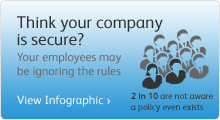 With more than 50,000 security threats emerging each day, protecting your business is a serious job. Understanding the various types of security threats can go a long way toward protecting your business. With multiple layers of protection in place, you can rest assured you’ve done all you can to prevent a breach. To protect your business from cyber threats at all levels, you have to understand how those threats target your business.
With more than 50,000 security threats emerging each day, protecting your business is a serious job. Understanding the various types of security threats can go a long way toward protecting your business. With multiple layers of protection in place, you can rest assured you’ve done all you can to prevent a breach. To protect your business from cyber threats at all levels, you have to understand how those threats target your business.
Assess Your Online Needs and Vulnerabilities
Every business and industry requires different security measures. If you run a legal practice, for example, and your team transcribes multiple documents daily, they can do so offline and store them directly on their hard drives. While the appeal of cloud storage is undeniable, the cloud carries risks. If you must use cloud storage, read their terms carefully so you understand which steps they take to keep your information safe. This applies to every aspect of your business, especially when it comes to online banking.
Make a list of every aspect of your business that involves working online in some capacity and make sure the sites and apps you use have the highest levels of security in place to protect you.
Ensure Your Employees are Educated
There are different types of cyber threats. Have you ever heard of social engineering? There are phishing scammers who look for personal information, such as bank accounts and credit card numbers, but some target the network itself.
You can research workshops and meetings that address cyber threats and require your employees to complete at least one every few years. Having a strong security policy in place is the first step, and it’s important that your team knows the rules and follows them. Cyber-attacks are an industry for those who make their living deceiving you. It pays to know how to counter those attacks.
Limit and Control Who Can Access Your Network
Let’s say you’re a doctor with a busy practice. You have an office computer on which you do most of your work, and so does your receptionist. You also have a couple of tablets for you and your nurse practitioner to use while seeing patients. Maybe your nurses each have a computer at their stations as well. All of those computers and tablets need to work together, connected to a single network that will undoubtedly need access to the internet.
You must protect that network. Each user should have a unique password to log in to each station or computer. Only your network administrator and yourself should have access to the network.
Set Rules for Online Usage
If their jobs require Internet access, consider providing your employees with a company cell phone with restricted features. This will allow them access to all the sites they need while allowing you to avoid the risks associated with an app running on their phones. You can block each computer from certain sites as well. As an extreme alternative, you can restrict Internet access so that employees only have access to sites that you deem safe and appropriate.
While that last example is one few, if any, businesses actually practice, restricting Internet access to only those sites you know you can trust goes a long way toward keeping your business safe from cyber threats. This is true for both computer and mobile Internet use.
Protect All of Your Equipment
In any office, even a home office, you’ll probably have a printer, at least. Many offices have a printer shared by multiple users as well as a fax machine. Contact the manufacturer or read the manual for your equipment to learn more about steps the company takes to ensure the safety of your documents. Here at Xerox we have a page on our website dedicated specifically to product security. When you go directly to the product manufacturer’s site, you can rest assured you’re getting correct information. Use sites you recognize by companies you are familiar with.
All businesses need to have an online presence to thrive in this digital age. Cyber terrorists know this and will exploit that necessity. It’s how they make their living. Learn how to protect your business from cyber threats and teach your employees to do so as well.
Ready made Tweets, click to share:
Tweet: The #cybersecurity basics every #smallbiz should know
Tweet: Think #cyberthreats are just for enterprise? Think again. #Smallbiz
Tweet: Avoid the losses that result from #security breaches. Learn the 5 ways #SMB’s can protect themselves.
About JT Ripton
JT Ripton is a business consultant and freelance writer who has penned articles for The Guardian, Business Insider and Entrepreneur.com among others. You can follow him and check out all of his latest articles on his twitter page @JTRipton




One of the brilliant items i have read in the week.
Thanks for the positive feedback, glad you liked the post!
Thanks for the great article! It’s crazy to think that two-thirds of U.S. employees are not concerned about confidential information being secureI I really like the fact that Xerox has partnered with McAfee and utilize their whitelisting defense technology against viruses.
Benjamin DeVries
Professional Document Solutions
http://www.pds-co.com
Thanks Benjamin. I think most people don’t think about security until it’s too late – when their information has been compromised. Having the right blend of people, technology and process in place is key to ensure security from all fronts. The great thing about having McAfee protection on Xerox ConnectKey devices is that it’s built in. You’re adding a layer of protection without asking your users to do anything extra.